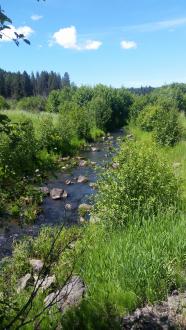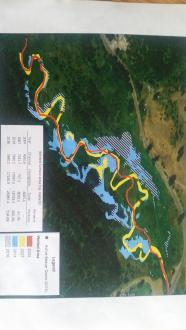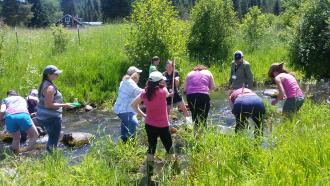Day 1: Restoring Equilibrium to Maximize Biodiversity of Benewah Creek
Submitted by Josh McKain on Mon, 2017-06-19 00:00
When you think of equilibrium, you think of a calm state of mind and a physical balance where opposing forces offset each other. Of course that is what us educators thought (early into our summer break) when we were able to explore the many reaches of Benewah Creek. Behind the scenes, drastic revitalization has occurred over the last twelve years, but there is still plenty of work for equilibrium to be restored. Stephanie Hallock, a Habitat Biologist for the Coeur d'Alene Tribe, led us through our first adventure.
The area of focus for the Benewah Creek Restoration Project is to restore the native ebb and flow of Benewah creek so West Slope Cutthroat Trout populations can be maximized and restored to pre-industrial farming and logging operations.
According to Stephanie, Benewah Creek was straightened dramatically in the early 1900’s for logging flumes. Native Cedar and Cottonwood groves were clear cut for farming and millwright operations in the area. These modifications temporarily maximized the ecological services provided by the area but decimated the ecosystems ability to maintain equilibrium and regenerate itself.
Erosion and sediment load runoff increased into Coeur d’Alene Lake due to increased water velocity. Overall water temperature increased and dissolved oxygen decreased due to decreased canopy cover over the creek. West Slope Cutthroat trout, the native species to the area, require a water temperature under 17 degrees Celsius to thrive. This has been difficult to maintain after the landscape was changed around 1908.
The Coeur d’Alene tribe and the wildlife mitigation unit have employed several practices to restore Benewah creek to its former glory so West Slope Cutthroat populations can be restored. For example:
Electrofishing is conducted continually to remove non-native brook trout that complete for resources. Deep pools, separated by shallow riffles, were created and the creek’s meandering flow was returned to its native banks. Fenced off areas with quarantined Alders have been planted to restore canopy cover.
All of this in the name of maximizing ecosystem services so that social-ecological systems and natural resources can be maintained for the future generations. Why is this important and how is it relevant to the classroom?
Today, English, Math, and Science teachers experienced firsthand how cross curricular collaboration in the field can maximize inquiry and place based education for a more vibrant learning experience. The consensus among the cohort was that by making these issues personal and relating them to the discourse that is taught, learning will become more appreciated and easier to sear into the minds of the future.
Questions to think about….
How can teachers across subject areas collaborate collectively so everyone can get into the field?
How can learning opportunities like these be presented to administration so students can get into the field?
What kinds of grants are available for funding to get students into the field?




Comments
Videos and Liability Release
Josh, Our district had a form the students and parents fill out at registration, so I just check with the class to see if anyone in class is not supposed to be in pictures/video and make sure there always out of the frame.
Marie: I definitley think the videos help create a bridge between environmental science and industry! Who doesn't like hands-on learning outside? Of course, it's important to be tactful. Many of the kids' parents make their living in the industry, and we don't want to alienate anyone from the science by pointing fingers at a "bad guy." Jamie Esler is a pro at keeping things positive while still examining the facts!